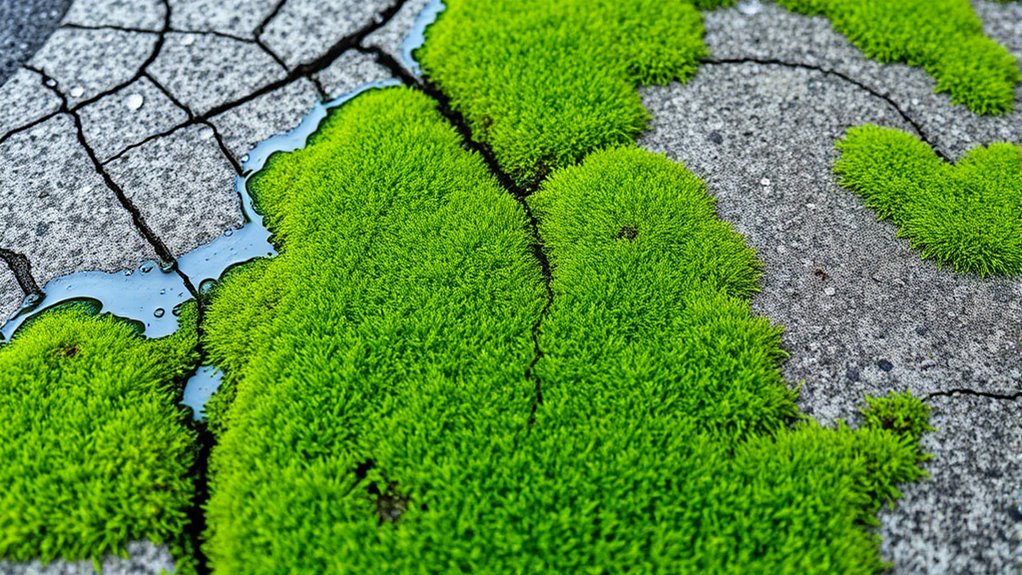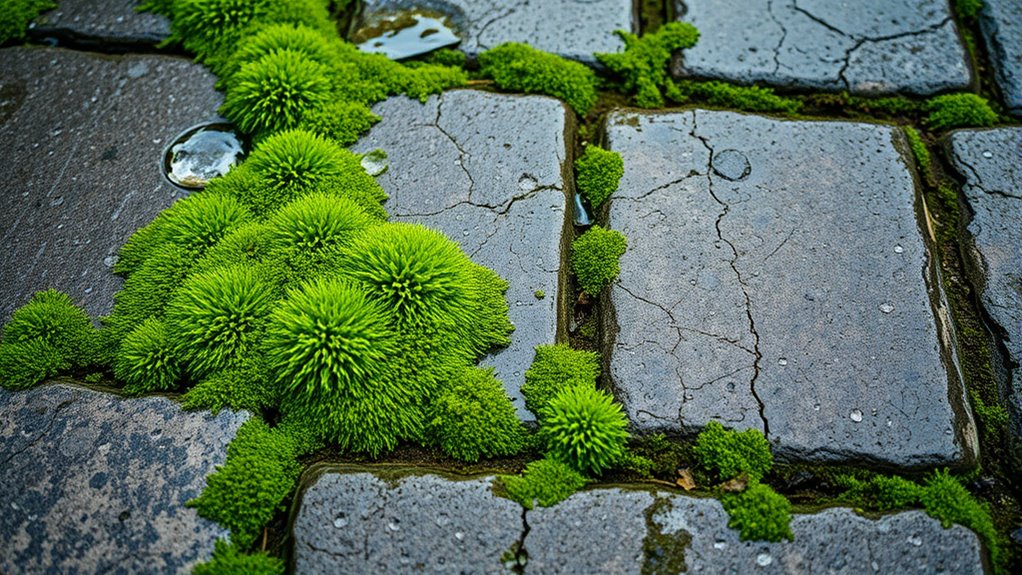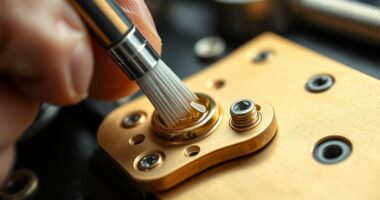To manage algae and moss growth on floors, regularly clean the surfaces using a stiff brush, water, and mild detergent or dedicated algae cleaners to remove organic buildup. Improve drainage, trim nearby plants, and increase sunlight exposure to prevent growth. For tough patches, use diluted bleach carefully. Keep moisture levels low with mats, dehumidifiers, and proper ventilation. Staying vigilant and acting quickly helps keep your floors safe—discover more effective strategies to protect your surfaces.
Key Takeaways
- Regularly inspect floors for early signs of algae or moss, such as green patches or slipperiness.
- Dislodge growth with stiff brushes or scrapers before cleaning with water and mild detergent.
- Use diluted bleach cautiously on tough patches, ensuring material safety and surface integrity.
- Improve drainage, trim shading vegetation, and increase sunlight exposure to reduce moisture and growth.
- Maintain consistent cleaning routines and apply preventative treatments like sealants or anti-moss solutions.

Have you noticed green patches or slippery spots on your floors? These can be signs of algae or moss growth, which not only look unsightly but also pose safety hazards. Algae and moss thrive in damp, shaded environments, making floors in certain areas more vulnerable. If you ignore these patches, they can become more extensive, leading to slippery surfaces that increase the risk of falls. Addressing this issue promptly is essential to maintain a safe environment.
To manage algae and moss growth effectively, start by understanding the importance of establishing a consistent cleaning schedule. Regular cleaning helps remove dirt, organic matter, and excess moisture that promote growth. Use a stiff brush or scraper to dislodge moss or algae from textured or porous surfaces, then follow up with a cleaning solution. For most surfaces, a mixture of water and a mild detergent or a specialized algae cleaner works well. For tougher growth, consider adding a diluted bleach solution—just ensure it’s safe for your flooring material. Scrubbing thoroughly breaks the bond algae and moss have with the surface, preventing new growth. Incorporating proper maintenance practices can further reduce the chances of recurrence.
Prevention is equally critical. Improving drainage around your floors reduces standing water, making the environment less hospitable for algae and moss. Trim back overhanging plants or shaded areas that limit sunlight, as algae and moss prefer shaded spots to thrive. Applying a sealant or anti-moss treatment to your flooring can create a barrier that discourages future growth. Also, ensure your cleaning schedule isn’t sporadic; consistency is key. Regularly scheduled cleanings, especially after rainy periods or in humid climates, keep organic buildup at bay and considerably reduce the chance of moss or algae spreading.
In addition to routine cleaning, you can incorporate preventative measures like installing mats or rugs in high-moisture zones, which absorb moisture and reduce water contact with the floor. Using dehumidifiers or improving ventilation in enclosed areas also helps keep moisture levels down, discouraging moss and algae growth. Be vigilant for early signs of green patches or slippery spots, and address them immediately to prevent larger problems. When you notice these patches, don’t wait—act quickly to scrub and clean the area thoroughly, and consider applying preventive treatments to keep your floors safe and algae-free.
Managing algae and moss on floors isn’t just about aesthetics; it’s about safety and maintaining the integrity of your surfaces. By establishing regular cleaning schedules, improving drainage, and taking preventative steps, you can keep your floors clean, safe, and free from slippery growths that threaten your environment.
Frequently Asked Questions
How Can I Prevent Algae and Moss From Returning After Cleaning?
To prevent algae and moss from returning after cleaning, you should apply preventive coatings that inhibit growth and improve drainage to reduce moisture buildup. Guarantee the surface stays dry by fixing any drainage issues, as standing water promotes growth. Regularly inspect and clean the area, reapplying coatings as needed. These steps create an environment less favorable for algae and moss, keeping your floors cleaner longer.
Are There Environmentally Friendly Treatments for Algae and Moss?
Did you know over 60% of environmentally conscious homeowners prefer biodegradable solutions? You can use natural remedies like vinegar or baking soda, which are effective and eco-friendly treatments for algae and moss. These biodegradable solutions help control growth without harming plants or wildlife. Regularly applying these natural remedies guarantees your floors stay clean while supporting sustainability. Embracing eco-friendly methods makes a positive impact on the environment and keeps your space safe.
What Safety Precautions Should I Take When Removing Algae and Moss?
When removing algae and moss, you should wear protective gear like gloves, goggles, and a mask to prevent skin contact and inhalation of spores. Always follow chemical safety instructions on any treatments you use, ensuring proper ventilation. Keep children and pets away from the area during and after the removal process. Handling chemicals carefully and using protective gear minimizes health risks and keeps you safe while effectively cleaning your floors.
How Often Should I Inspect Floors for Algae and Moss Growth?
An ounce of prevention is worth a pound of cure. You should inspect your floors regularly, ideally monthly, to catch algae and moss early. Seasonal monitoring is essential, especially during wet or humid months when growth accelerates. Frequent inspections help maintain safety and prevent damage, so stay vigilant and adapt your inspection frequency based on weather conditions. Regular checks keep your floors safe and algae-free.
Can Algae and Moss Growth Damage the Underlying Flooring Material?
Algae and moss growth can indeed cause floor damage by promoting material degradation over time. As these organisms retain moisture, they weaken the surface, leading to cracks, warping, or other structural issues. If you ignore this growth, it accelerates damage, compromising the floor’s integrity. Regular inspections and prompt removal are essential to prevent material degradation and preserve the longevity of your flooring.
Conclusion
Remember, an ounce of prevention is worth a pound of cure. Regular cleaning and proper drainage can keep algae and moss at bay, saving you time and effort in the long run. Don’t wait until the problem spreads; act early to maintain safe, beautiful floors. By staying vigilant and proactive, you’ll keep your surfaces clear and inviting, proving that a little effort now prevents bigger issues later. Keep your floors dry and clean, and they’ll serve you well.









